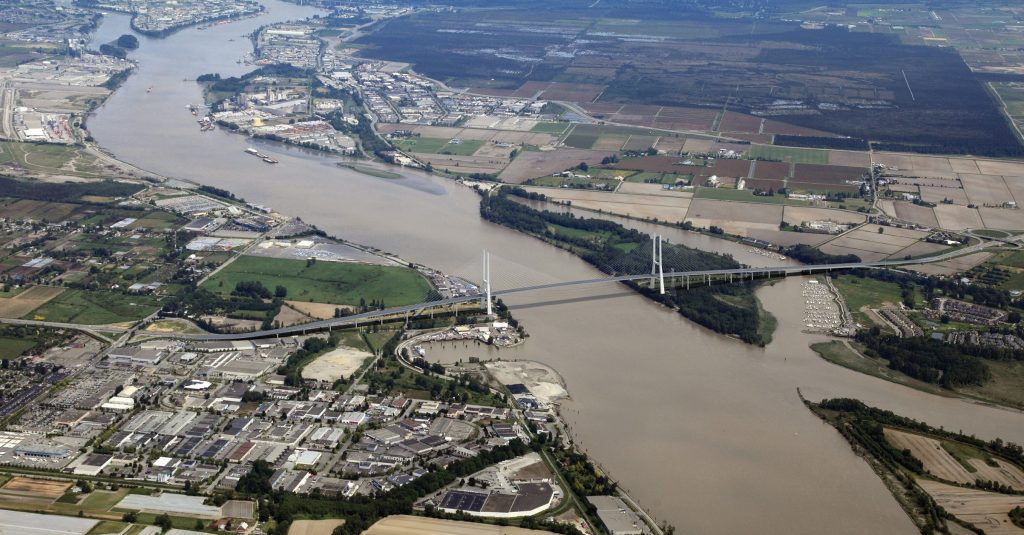
Features
Projects
Roads & Paving
George Massey Tunnel Replacement receives Environmental Assessment Certificate
February 15, 2017 By Government of B.C.
 Conceptual design of the new bridge Courtesy of the Government of B.C.
Conceptual design of the new bridge Courtesy of the Government of B.C.February 15, 2017 – B.C.’s Ministry of Transportation and Infrastructure was recently issued an Environmental Assessment Certificate for the George Massey Tunnel Replacement project by Environment Minister Mary Polak and Community, Sport and Cultural Development Minister Peter Fassbender.
The George Massey Tunnel Replacement project includes the building of a new 10-lane, clear span bridge over the south arm of the Fraser River; the replacement of the Westminster Highway, Steveston Highway and Highway 17A interchanges; the widening Highway 99 between Bridgeport Road in Richmond and Highway 91 in Delta to accommodate dedicated transit/high occupancy vehicle lanes; and the decommissioning the George Massey Tunnel.
The decision was made after considering a review led by British Columbia’s Environmental Assessment Office. The ministers have issued the certificate with legally enforceable conditions that have given them the confidence to conclude that the project will be constructed and operated in a way that ensures no significant adverse effects are likely to occur. A record of the factors that the ministers considered in making their decision can be found in the Reasons for Ministers’ Decision at: https://projects.eao.gov.bc.ca/p/george-massey-tunnel-replacement/docs?folder=89.
There are 33 conditions that are part of the Environmental Assessment Certificate. Design requirements are specified in the certified project description. Each of the conditions and the certified project description are legally binding requirements that the Ministry of Transportation and Infrastructure must meet to be in compliance with the certificate.
Key findings that assisted ministers in concluding that no significant adverse effects are likely to occur from the project include:
• the design of a clear span bridge across the Fraser River to avoid instream footprint effects on fish and fish habitat;
• tunnel decommissioning would not result in changes to the size of vessels using the Fraser River; and
• analysis that indicated the project would eliminate congestion delays and idling at the tunnel, providing relief for a number of local Richmond roads.
Key conditions and requirements mean that the Ministry of Transportation and Infrastructure must:
• Develop a management plan to minimize potential impacts on fish and fish habitat during project construction;
• Develop a fish habitat offsetting plan that includes restoration of Green Slough and Deas Slough;
• Establish a marine users group and develop a plan to manage marine access during construction to reduce potential disruption to commercial, recreational, or Aboriginal marine users;
• Ensure access to fisheries for Aboriginal and commercial fishers during project construction;
• Participate in any initiatives related to the monitoring, assessment, or management of cumulative environmental effects;
• Develop a traffic and access management plan and establish a transportation working group for Highway 99, in order to share the results of traffic monitoring data and identify and discuss the operation of transportation infrastructure and the integration with adjacent infrastructure; and
• Continue to consult with Aboriginal groups, including during the development of management plans, and provide opportunities for Aboriginal groups to participate in environmental monitoring activities.
The George Massey Tunnel Replacement project will require various federal, provincial and local government permits to proceed. The Environmental Assessment Office will co-ordinate compliance management efforts with other government agencies to ensure that the office is satisfied that certificate conditions are met throughout the life of the project.
British Columbia’s Environmental Assessment process offers significant opportunities for Aboriginal groups, government agencies and the public to influence the outcome of environmental assessments by providing input on the potential for environmental, economic, social, heritage and health effects from a proposed project.
Print this page